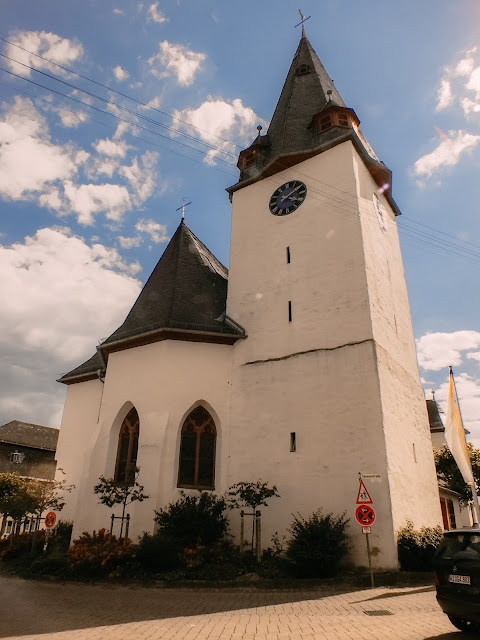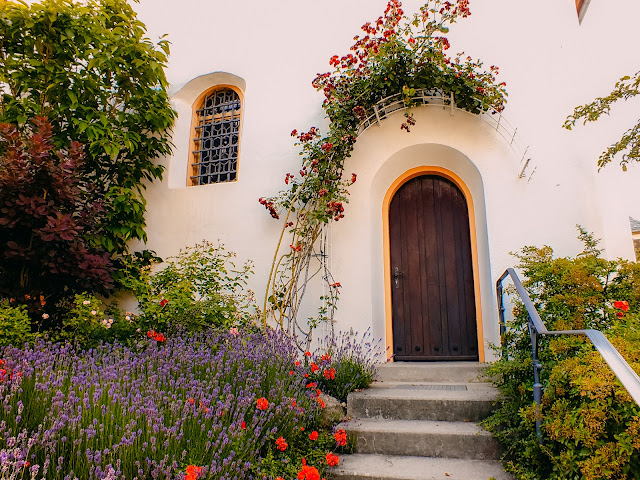hallgarten fairground.
this was a fairly small walk around the little village of hallgarten, which is a part of the town of oestrich-winkel. it is nestled against the mountainside of the rheingau hills, underneath the village's landmark mountain hallgarter zange. i remember starting my walk in the village's newer part, the settlement 'am rebhang', which has direct access to the woods. after walking for a little bit i encountered the local event venue, which was a little hidden, actually and i mistook it first as an abandoned structure. apparently, though, this place is used by the hallgarten people for gatherings, parties, concerts and seasonal events.
i actually loved the shadowplay the roof created on the grass. accidental geometrical art!
i also remember eating sour cherries here which i found on the trees around the premise.
view over freshly hewn hay fields down into the rhine valley.
i didn't mess around for long in the woods, though i should probably try again at some point and have a hike up the hallgarter zange to the tower, which has been renovated in the last few years. i made my way back to hallgarten through the vineyards, enjoying more views of the valley.
from afar you could already make out hallgarten's church 'mariä himmelfahrt' ( assumption of mary ). in the back is what i suppose is the city of ingelheim, which lies beyond the rhine river in the state of rhineland-palatinate.
over hallgarten's roofs.
eventually i stepped into the village to explore it a little more. i liked this house's wall decor a lot.
the friedensplatz - a square to commemorate fallen soldiers of the franco-prussian war and the first world war. the chapel was built in 1892.
always very fond of brickstone cladded houses! the old village core of hallgarten is not very big, but some of its streets are very charming!
the village's church mariä himmelfahrt was first mentioned in the 12th century, some romanesque elements from that time are still visible in the otherwise gothic & baroque church. the tower for example is a proof of that but also the northern nave walls. the church is known for the schroetermadonna ( or madonna with shard ), a pottered sculpture of st. mary and her child. it was created around 1417 and what makes it special is the fact that during a time when most sculptures were hewn out of stone or carved from wood, this particular sculpture was made out of clay.
the church's surroundings show quite distinctly the germ cell of the village, all still feels narrow and snug, a sign of medieval town building. the sweet timber frame building in the back dates back to 1657.
i adored this entrance into the church! just beautiful with all the roses and lavender blooming!
crucifixion group in the churchyard. it seems to be a leftover of a bigger altar from the hans backoffen workshop, probably created in the 16th century.
more pedicles were gracing the churchyard walls.
another entrance of the church. ( perhaps today's main entrance? )
i liked this forlorn jesus head!
moved on to more explorations through the village, and fell in love with this bold gate. it is part of the farm estate kartäuser hofgut. it was part of the kartäuser monastery in mainz ( though it isn't existing anymore ). buildings date back to 1728.
this street led out to the vineyards again, and you passed by some dreamy estates. the yellow house belonged to the former wine-growing estate fürst löwenstein. i think the company still produces wines from hallgarten's vineyards, but i found out that the current estate is in kleinheubach in franconia, apparently they don't operate in hallgarten big time anymore.
the manor house of the family von itzstein. this building was a meeting hub for people around adam von itzstein - a german parlamentarian for the liberals during the formation of the frankfurt parliament ( 1848 ), which was the first freely elected parliament for all german states. adam von itzstein led the hallgartenkreis, which was basically a club for influential politicians, thinkers & creatives that were fighting for a more democratic germany. nothing much came of this assembly, though, it is said that these meetings involved more wine drinking than serious discussions about how to form a more diverse political landscape ;)
the manor was probably built in the early 18th century, there's no exact date to be found.
i liked this little addition to the manor - coming off like a tiny house. let me move in please! i am still on the lookout for my own personal dream house, it would be so nice to have enough money to buy a tiny house. i'd also be happy renting one if it meant i can rent it forever ;D
and once again ends a little exploration, and it for sure won't be the last. the rheingau has so many litte villages to explore and sometimes little secrets only reveal themselves to you when you stumble upon them by accident or when you research after. for hallgarten, i think, what will be next on my itinerary, is gonna be a revisit to the hallgarter zange and a forgotten castle around there ( haneck castle ).




























Comments